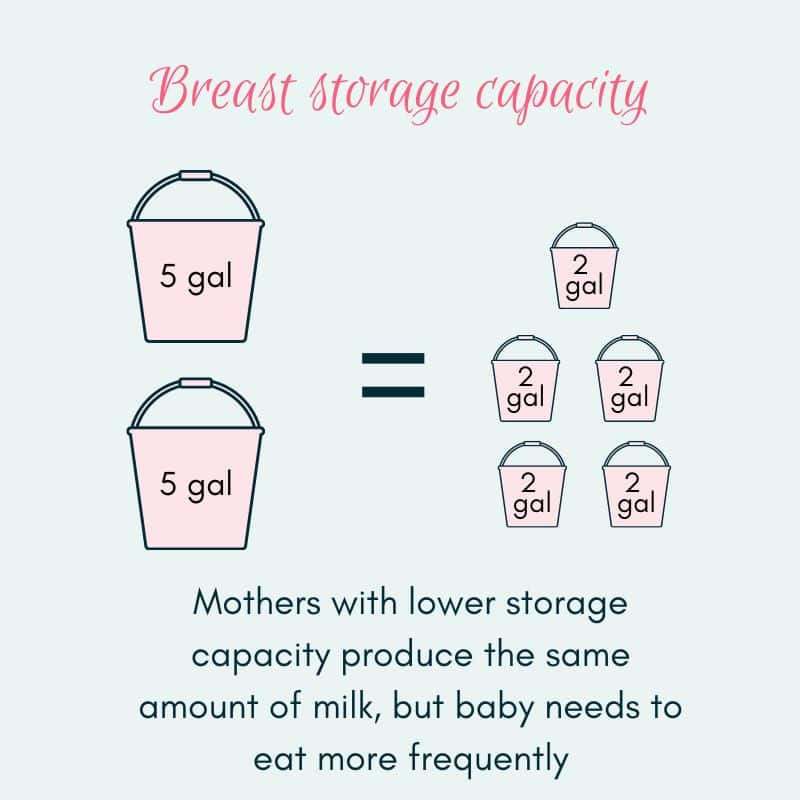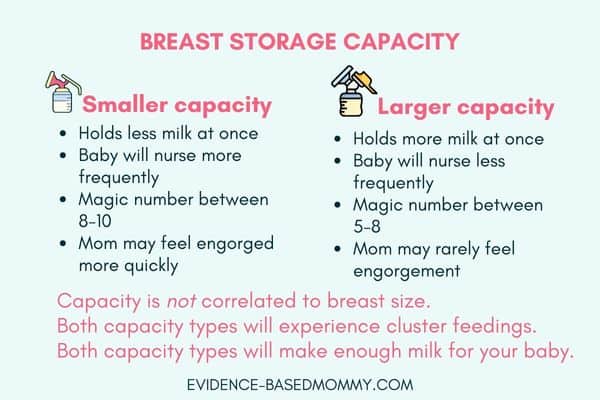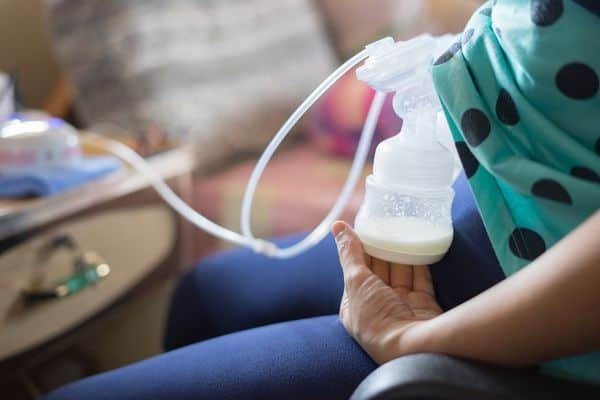What is the breastfeeding mother’s magic number? Turns out, it’s not a number at all, but rather, a term that’s related to breast milk capacity, the amount of breast milk that can be stored in the breasts.
Table of Contents
What you should know:
- Breast storage capacity is the volume of milk your breasts can hold at one time.
- The average breast capacity is 2-4 oz per breast. Breast capacity has nothing to do with the size of your breasts.
- Storage capacity is unrelated to your ability to make milk, only to how much milk you can store before your breasts are too full.
- Your breastfeeding “magic number” is the number of times you need to breastfeed or pump in order to keep a good milk supply.
- Regardless of your breast capacity or magic number, it is best to feed your baby on their cue, not according to a schedule.
Understanding breast milk storage capacity can help you better plan your day and feedings. Here we’ll discuss what it is, how it relates to your “magic number,” and some tips for working with your breast storage capacity.
What is breast storage capacity?
Breast storage capacity is simply the volume of milk your breasts can hold at one time. The average breast capacity is about 2-4 oz per breast, although this can vary.

Notice that storage capacity is not the same as the ability to produce milk. Milk production is all about supply and demand: Nursing increases a mother’s levels of prolactin (the hormone that stimulates milk production). This means the more milk is removed from the breast (whether by nursing or pumping), the faster a mother will make milk to replace it. That’s why it’s so important to pump or feed consistently (especially in the first few days after baby’s arrival).
RELATED: Bonding with baby in the first 48 hours after birth
Breast milk contains another chemical called the feedback inhibitor of lactation (FIL). If milk isn’t removed from the breast, FIL will tell the breast to stop making milk. So letting your breasts stay full will lower your breast milk production.
Since breasts with lower capacity fill up faster than breasts with larger capacity, people with lower milk capacity will need to empty their breasts more often (through either nursing or pumping).

If you lucked out and have a large milk storage capacity, it isn’t as critical that you frequently empty your breasts (however, it’s still smart to pay careful attention to your milk output and to your baby).
I have a larger capacity (lucky me, I know). I was able to pump only 2 times per day when I was working outside the home and still maintain supply. If I skipped a pumping session because I felt too busy, I was able to bring my supply back up pretty easily by focusing on more frequent pumping over the next day or two.
RELATED: Is my milk drying up? Help!
What determines breast capacity?
Breast capacity doesn’t depend on the size of your breasts. You can have small breasts and be able to store a lot of milk, or you could have larger breasts and a low breast capacity. Instead, it is determined by the number of mammary lobes you have – the glands that produce and store breast milk.

Usually, your breasts will increase by a cup size (or two!) during pregnancy. That’s a sign of your breasts producing new mammary tissue so they can hold more milk.
You may grow more mammary glandular tissues with each pregnancy, increasing your capacity slightly with each. At the same time, you may also increase your milk production rate with each pregnancy too.
Heartbreakingly, some mothers (through no fault of their own) have insufficient glandular tissue (IGT), where they simply cannot produce enough milk for their child. Clues that a mother may have IGT include tubular-shaped breasts, wide spacing between breasts, or no change in breast size during pregnancy.
The breastfeeding magic number

Your “magic number” is the number of times you need to empty your breasts per 24 hours in order to keep your supply robust.
Most people’s magic number is around 8.
With that said, the “magic number” is related more to pumping than to nursing. Especially for newborns, your baby should be eating around 10-12 times a day (or more if they’re in a cluster feeding stage).
RELATED: Tips for newborn breastfeeding
RELATED: Advantages of breastfeeding
However, your magic number can change based on your breast storage capacity.
- Those with a larger capacity may have a magic number of only 5 (where they can pump/nurse only 5 times per day with no drop in supply),
- Others with a lower capacity may have a magic number of 10.
With that said, if you’re feeding on demand, your magic number doesn’t really matter. That’s because you’ll be paying attention to your baby’s cues and nursing based on that, not based on a number that’s hard to determine.
Feeding on your baby’s cues is what’s best for you both – not worrying about your storage capacity or magic number.
Your magic number and pumping
Your magic number becomes more important if you’re pumping (if you work away from your baby, for example). You might not need to think in terms of How many times per day should I pump? but instead consider, How many times per day do I need to empty my breasts?

If you nurse your baby right before you go to work, right as soon as you get out of work, and then at regular intervals (every 2-4 hours) for the rest of the day, how many nursing sessions do you have? Subtract this from your magic number to know how many times you should pump.
For example, if your magic number is 8 (which is a good start to guess with), and your baby nurses 6 times from when you get home until you drop them off at daycare the next day, you may only need to pump 2 times instead of 3.
On the plus side, your baby doesn’t need more milk as they get older. For the first 6 months, your baby always needs around 25-30 oz (750-900 mL) of milk per day. So don’t worry that you’ll need to keep increasing the amount of milk you pump as your baby grows – it’s okay!
How does my magic number impact breastfeeding at night?
You also need to consider your magic number if you try to night wean. A baby often nurses 2-3 times at night, so by losing those sessions, you’re losing around a third of the sessions you could expect in a day. Plus, your prolactin levels are higher at night, so it’s even more important that you drain your breasts more than just during the day time.
(This is why I recommend waiting to night wean until your child is at least a year old, by the way.)
RELATED: Surviving night time cluster feeding
Keeping your little one nearby in a co sleeper bassinet will make night time feedings much easier (plus, room sharing with your infant is recommended by the American Academy of Pediatrics).
RELATED: The best non-toxic co sleeper bassinets
Can you increase your breast storage capacity?
For the most part, you can’t control your breast storage capacity. Instead, you’ll need to manage your routine to work with your breasts’ capacity and how often they need to be emptied (I know, easier said than done).
In fact, many breastfeeding professionals (including Dr. Sheela Geraghty, IBCLC), don’t even think we should worry about “breast capacity.” Instead, we should focus on nursing babies on demand.
Any time your baby signals that they are hungry (lip smacking, head turning as if they’re looking for your breast, gnawing on their fist), go ahead and feed them. As they say, watch the baby, not the clock.
Conclusions on breast capacity and the magic number
I hope this article is reassuring: You don’t have to know how many ounces your breasts hold to successfully feed your baby. Instead, the main thing is to feed on demand and trust your body.
If you need extra help, make sure to grab Breastfeeding 101, my free guide to breastfeeding success. You’ve got this!

This is really reassuring. I wasn’t sure how I could figure out what my capacity was, but I guess it’s okay to not know an exact number. Thanks!